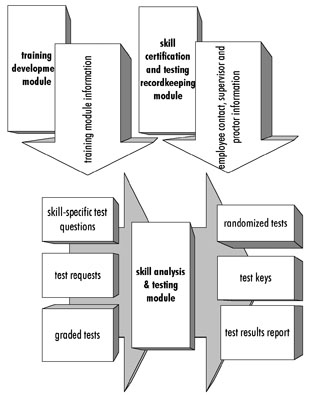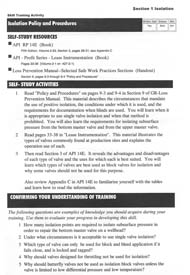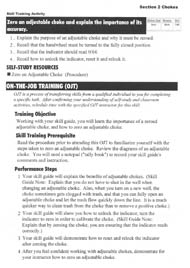|
Training
development module reduces training development and delivery costs
SkillForge is designed to simultaneously reduce the cost of training
development and delivery and provide more comprehensive, focused
training. SkillForge uses several techniques to do this.
- First,
SkillForge takes advantage of precise skill definitions to focus
training and eliminate unnecessary training.
- Second,
it integrates existing training materials rather than recreating
them. By selecting existing components relevant to the skills
being taught, and by delivering those components in the most efficient
fashion, SkillForge reduces costs and eliminates needless recreation
of training. In a similar way, training materials provided by
third parties can be incorporated into the curriculum, in whole
or in part.
- Third,
SkillForge lets companies use low-cost training resources. Most
companies have many more training resources than they realize,
once they look beyond formal training texts or courses. Some of
the items companies have found useful include suppliers’ sales
literature and operations memos. Items such as these can be very
instructive when tied to the appropriate skill and supported by
clear instructions on how to apply the information.
- Fourth,
wherever possible, SkillForge provides the training in a self-study
format. It also provides very specific, guided on-the-job training
(OJT) exercises where they are needed. Each study activity or
OJT exercise is focused on a specific skill and a specific outcome.
This can greatly reduce the time spent on OJT and make the time
spent much more productive. With SkillForge, no training is created
without a clearly specified performance outcome. Training is quick
and focused. Students know their goal and know when they have
reached it.
- Fifth,
automated training module publication is a built-in feature. SkillForge
directly outputs the training as booklets or electronic documents.
With SkillForge, there is no word processing or page layout.
Developing
the most efficient training
 The
illustration to the right is a schematic of principal inputs and
outputs of the Training Development Module. The SkillForge system
provides a way to efficiently identify and analyze all relevant
training resources. First, all resources that might be relevant
are cataloged and linked to all relevant skill areas. Employees
are often able to identify the primary resources and many unexpected
ones as well. Subject experts and developers can provide information
about additional third-party resources. The
illustration to the right is a schematic of principal inputs and
outputs of the Training Development Module. The SkillForge system
provides a way to efficiently identify and analyze all relevant
training resources. First, all resources that might be relevant
are cataloged and linked to all relevant skill areas. Employees
are often able to identify the primary resources and many unexpected
ones as well. Subject experts and developers can provide information
about additional third-party resources.
Training
resource assessment reports
Subject matter experts can review and assess training resources
using SkillForge reports. Subject matter experts select the specific
parts of each useful resource that best teach each skill. SkillForge
enables developers to link the relevant paragraphs and sentences
to eliminate unnecessary study. SkillForge reports help identify
the most useful resources and eliminate redundant ones. Reports
enable subject matter experts can see what resources have the broadest
application and focus on using them. They can also eliminate redundant
resources. This kind of analysis enabled one client to reduce the
number of training resources inventoried by two-thirds.
Skill
Qualification Guides
To create training modules, developers define the module and
section titles and group the corresponding skills into them.
Skill Qualification Guides provide learners with a self-evaluation
tool and links to the corresponding training modules. Training
instructions—both self-study and OJT—are then added to the skill
information. SkillForge automatically outputs comprehensive
training modules. In one engagement this automation enabled
a client to produce 740 different training titles in a three-month
period. The following illustrations show two pages from representative
Skill Training Modules.
Training Modules
Each
training activity restates the skill objective and criteria. |

A
typical SKILL QUALIFICATION GUIDE page. Click on the image to
see a full-size page. |
Next
it lists any training resources that are used. (When the modules
are produced as on-line electronic documents, these listings serve
as Hypertext Links to the actual resource.)
After
general instructions, the module presents step-by-step training
instructions. At the end of each activity, questions enable the
student to test his or her understanding. Training activities can
incorporate both self-study and OJT exercises.

A
typical SELF-STUDY MODULE page. Click on the image to see a
full-size page. |

A typical OJT MODULE page. Click on the image to see a full-size
page. |
The
training library module reduces training development and delivery
costs
When modules are defined, the system logs all titles into the Training
Library Management Module. The module manages the company’s inventory
of skill qualification guides, training modules and training resources.
It records entries into and shipments from inventory. SkillForge
reports when items fall below preset inventory levels and it automatically
produces purchase requests. When a request for training is received,
SkillForge pulls employee contact information from the Skills Certification
and Training Records Module, records the request and produces shipping
labels and pull lists. When an item is out of stock, SkillForge
creates a backorder for the student’s request. The automation features
of the SkillForge Training Library Management Module reduce the
cost of managing a training inventory.
|


 The
illustration to the right is a schematic of principal inputs and
outputs of the Training Development Module. The SkillForge system
provides a way to efficiently identify and analyze all relevant
training resources. First, all resources that might be relevant
are cataloged and linked to all relevant skill areas. Employees
are often able to identify the primary resources and many unexpected
ones as well. Subject experts and developers can provide information
about additional third-party resources.
The
illustration to the right is a schematic of principal inputs and
outputs of the Training Development Module. The SkillForge system
provides a way to efficiently identify and analyze all relevant
training resources. First, all resources that might be relevant
are cataloged and linked to all relevant skill areas. Employees
are often able to identify the primary resources and many unexpected
ones as well. Subject experts and developers can provide information
about additional third-party resources. 

